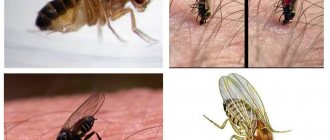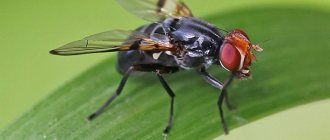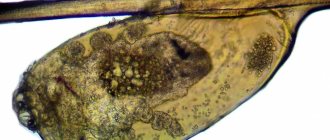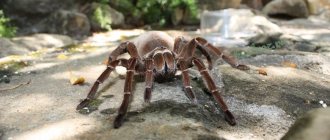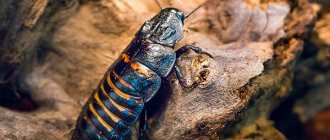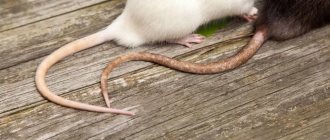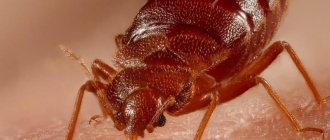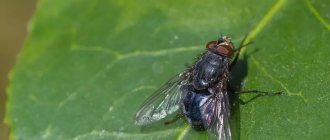general information
Age
Let's start the story with the question posed in the title, let's find out how long the common fly lives.
In fact, flies do not live very long; their average lifespan is between one and four weeks. If the temperature is kept at 20-25 degrees and there is enough food, then individual individuals are able to not die for two months.
On a note! We are talking, of course, about the imago - an adult insect!
About nutrition
To the question of what flies eat, the answer is simple - almost everything that has an organic basis. However, they are big gourmets and prefer sweets.
They eat liquid food most easily, because the fly's mouthparts are a proboscis, which is not capable of gnawing food. When flies have to make do with solid organic matter, they first soften it with saliva and then suck it up.
Interesting! The taste buds of a fly are on its legs, so when crawling over food, the fly tastes it.
About limbs
The legs of insects also raise many questions, from the most naive, how many legs does a fly have, to the rather serious and interesting ones. The fact that a fly, like other insects, has six legs is taught in school, but the question of why flies rub their legs, asked by a curious child, can confuse more than one dad.
It turns out that this is a standard hygienic procedure. Flies, flying from sewage to food, collect various debris on their legs and, naturally, get dirty. In order to clean their paws from the dirt stuck to them, flies wipe their paws one against the other, and thus clean themselves. First they rub their forelimbs, then they use them to clean the head, and then their hind limbs - the wings.
Now to the question of how the fly stays on the ceiling.
Many authors believe that insects cling to the smallest protrusions on the surface with hooks on their legs that are barely visible to the naked eye. But this is the wrong point of view; how else can we explain the tenacity of flies on completely flat surfaces, for example, glass.
It turns out that there is a very simple explanation for this phenomenon. The fact is that the protrusions on the legs of the fly are not hooks at all, but tiny capillaries. Through them, insects secrete a kind of sticky liquid onto the surface, which then holds their light body on a vertical or horizontal surface.
If a fly decides to launch from a ceiling or wall perpendicular to the surface, like a rocket, then the tensile force generated by this adhesive composition will not allow them to do this. Therefore, insects are forced to take off tangentially, similar to an intercontinental airliner.
About brains
Now let's think about this topic: does a fly have a brain? It would seem, why does such a small creature need it? However, in the head of an insect there are about three hundred thousand neurons, which, of course, is nothing compared to our twenty billion such cells, but still...
This number of active cells is enough for a small creature to be active and fulfill its most urgent needs.
About the eyes
Looking at the eyes of a fly, many wonder about their vision. In fact, we do not see the usual proteins and pupils inherent in mammals, and often we cannot understand how a fly sees.
In fact, they, like many other insects, have so-called “faceted” vision. The eye consists of many tiny sectors. each of which is responsible for displaying a small area of space. Then the tiny fly brain, discussed in the previous chapter, puts the pieces of information together, and the fly represents the whole picture around it.
This eye arrangement allows the fly to see a 360-degree image, and in color. And the optimal frame rate for her is not 24 per second, like a human’s, but as much as 300.
About the heart
Does a fly have a heart, and in which egg is hidden the needle that will kill it like the famous Koshchei?
In the same sense as humans, flies are heartless. But still, the organ that moves their blood through a single straight artery also exists in these insects.
This phenomenon is explained by the fact that, unlike mammals, the blood of insects does not carry out the function of delivering oxygen to the most important parts of the body. Roughly speaking, flies breathe through their skin, not their lungs.
Description of appearance
All flies have similar morphological characteristics.
- The body is oblong, densely covered with villi. The fly consists of a head, chest, and abdomen. There are transparent wings on the back and antennae on the head. 6 pairs of limbs that allow the insect to hold on any surface in a horizontal or vertical position.
- The head is small, most of it is occupied by compound eyes. Behind them are three simple eyes. The oral apparatus, the proboscis, extends from the lower jaw. In blood-sucking flies it is piercing, cutting and sucking. For everyone else, it only allows them to lick food.
- The limb is five-segmented; the last segment houses the organs of smell and touch. A fly uses its legs to analyze the quality of food better than a human with its tongue. Fatty glands on the legs allow the fly to cling to smooth surfaces and ceilings.
- The wings are transparent, only two pairs, which distinguishes flies from other insects.
- The body color is different - gray, green, blue, spotted, black. The house pest is characterized by a gray color.
Life cycle
The life cycle of a fly has several stages. In them, like in many species of insects, the formation of an adult individual occurs in four stages:
- egg;
- larva;
- chrysalis;
- adult (imago).
Each adult female is capable of laying eggs 6-10 times throughout her life, and a clutch can contain from 50 to 150 eggs. The individual is capable of reproduction within a few days after emerging from the pupa.
Eggs and larvae
Leaving behind offspring is the main goal of all living organisms on the planet. And the housefly is no exception. But, as practice shows, the more developed a creature is, the fewer offspring it can produce during its lifetime.
Under favorable conditions, the fly begins to multiply rapidly
There is a hypothesis about the brain, the construction of which takes the most substances from the mother’s body. But since insects do not have high intelligence, their offspring can reach several thousand individuals.
This video talks about the dangers of house flies:
They lay their clutches in places where the hatched larva will not need to look for food. This is stale food or rotting garbage. It is very difficult for a person to detect the nest, since the size of one egg does not exceed 1.2 mm. The eggs are white and oblong in shape. The period of their full maturation takes no more than two days, after which the larvae appear.
The larvae of these winged insects are usually white and cone-shaped with a mouth cavity at the narrow end. They can grow up to 13 mm in length. They feed on the waste in which they were born and grow in size very quickly. People call them maggots and use them as bait for fish. Today, maggots are specially bred for sale in fishing stores. This bait should be stored in the refrigerator to slow down the pupation process, which usually occurs after 3 molts.
Formation of pupae
The maturation process of maggots can last from 3 to 25 days. It depends on the amount of food and the warm environment. Temperature conditions +25…+30°С are the most favorable for the rapid development of larvae. Having reached the desired size, the maggot crawls to a cool place and begins to form a pupa.
After passing through three stages of growth, the larva turns into an adult.
The pupa has the same shape and size as the larva. Fishermen also use cocoons as bait and call them caster. The shell gradually hardens and turns brown.
Usually, the larva remains in the form of a caster for about a week, then an adult emerges from it. But if climatic conditions are not favorable for birth, then the fly may delay its birth. The pupa can remain in this state for quite a long time. There are cases where this condition lasted for several years.
Emergence of an adult
After complete formation, the adult insect is born, and after three days it becomes capable of producing its own offspring. How long a common fly lives is influenced by factors such as:
- climatic conditions;
- concentration of harmful substances in the air (flies breathe through the skin);
- habitat.
The main period of activity is observed in the warm season; in cold seasons, the fly hibernates.
Typically, the lifespan of an ordinary fly is about 30 days. If we add here two days as an egg, a period of 20-30 days for the larvae to mature and the time of pupation, it turns out that the complete life cycle of a fly is about 2.5-3 months.
But you need to make allowances for climate and environment, and also take into account the type of insect, because flies, like other living beings, are very different from each other.
Gadflies
These large flies occupy an intermediate stage between oviparous and Wohlfart. Gadfly larvae also parasitize living organisms, but they reach the host in the egg stage.
The gastric botfly lays eggs on animal fur. When they lick the eggs from the fur, they end up in the stomach. Only after this does the larva emerge and begin its development in the host’s gastrointestinal tract.
The subcutaneous lays eggs on the fur. The emerging individual independently goes deep under the skin, where it passes through all stages of development in safety, leaving the host only before pupation. Sheep and horse gadflies "splash" eggs into the eyes and nasal cavities of animals in the same way as the Wohlfarth fly does with larvae.
Appearance
Body length is 9 mm-2.5 cm. An adult has a wide head with large eyes and short antennae. There is no proboscis, or it is reduced. The legs are massive and short. The abdomen is round or conical. The entire body is covered with coarse hairs. The life of gadflies is short - approximately 22 days.
Classification
- Hypodermatinae (Subcutaneous). Adults lay eggs on the hair of domestic animals: horses, rams, cows. The hatched larvae penetrate the skin and move through the tissues. Before entering stage II, they gather under the skin, forming inflamed fistulas. Through them the larvae get to the surface.
- Gasterophilinae (Stomach). There are 2 ways for larvae to enter. Some females lay eggs on leaf food, and they enter the animal with food. Others - on the head and chest. The cattle, by biting and licking the skin, transfer the eggs into the digestive tract.
- Oestrinae (Cavity, nasopharyngeal). Females release eggs in flight, which land on the mucous membranes of the eyes and nose. People often suffer unwittingly: as a result, conjunctivitis (very dangerous for a child) and other diseases can develop.
Some scientists classify Cuterebrinae, the American subcutaneous gadfly, as a separate subfamily. They most often parasitize mice, hares, gophers, etc.
Danger to humans
Some subcutaneous species, such as Dermatobia hominis, attack humans. Bodfly larvae penetrate the skin, causing a lot of suffering. Cases have been recorded where a person died from the penetration of parasites.
Gadflies are inventive in attack: some distract, others attack. Their legs are soft, so you may not notice when a fly lands on your skin. But its bite is very painful, burning. Redness appears in this place and itching begins.
Human blood serves as a breeding ground for eggs. The hatched larvae, looking for a way out, move upward. If they get into the brain, death is inevitable.
Musca domestica, house fly
Flying insects of this species live only where a person lives, or in maximum proximity to him. They are practically never found in the wild. On the territory of Russia there are 2 subspecies of house flies - common and southern.
The development speed and lifespan of insects is very dependent on the ambient temperature. The range of 23-25 °C is optimal for it; at this temperature, an adult can live up to 8-9 weeks, while the standard life expectancy is only 3 weeks.
The house fly goes through several stages of development:
- Egg. Develops from 8 to 50 hours.
- Larva (maggot). She molts three times before becoming a pupa. This takes her from 3 to 25 days.
- Doll. The insect goes through this stage in about 3-6 days.
- Imago (adult insect). Lives from 2 weeks to a month, sometimes up to 2 months. 36 hours after the transition from the pupal stage to the adult, the fly is capable of reproduction. During her life she lays about 2000 eggs.
In addition, when the temperature drops, adults, larvae and pupae are able to hibernate, additionally living in sleep for several more months. Under favorable conditions, insects of this species reproduce continuously throughout the year.
general characteristics
According to various sources, there are currently about 80,000 different species of flies on planet Earth. But at the same time, the most common is the indoor one, which is quite rare in nature.
The size of an adult housefly reaches 0.6-0.8 cm. On the body, which has a gray color, in the chest area on top there are four longitudinal stripes of black color, while the bottom of its abdomen is yellowish in color.
The entire body of the insect is covered with long, sparsely growing hairs. The eyes are faceted, large in size, and dark red in color. Females are larger than males. During flight, only the front wings are used, similar to all dipterans. And the back pair of wings is needed solely so that the insect can maintain balance while in the air.
What is the weight of the fly?
A medium-sized insect weighs about 0.12-0.16 g. The mass of an African insect can vary from 0.012 kg. up to 0.015 kg. The length of the carrion is almost several times greater than that of its indoor relatives, and its weight is 0.025 - 0.032 kg. Regardless of how much a fly weighs, anyone can feel it on their body. This happens solely due to the movements that the insect makes.
How long can flies live?
Another interesting fact is how long the common fly lives. Its lifespan is approximately 10-20 days, and in the most comfortable temperature conditions for it - up to 1.5 months. The best conditions for her life are considered to be +22-26 degrees with air humidity not exceeding 80%.
These insects survive at ambient temperatures from +11 to +45 degrees, which undoubtedly affects their lifespan. As the temperature drops, the activity of the insect also decreases. With the onset of cold weather, already at +10 degrees and below, its activity drops, and it goes into hibernation. The duration of this state directly depends on the air temperature. Fly pupae and larvae can also hibernate, allowing them to survive in their environment.
Flesh and carrion flies
Flesh flies and carrion flies can also be easily confused with a housefly; they look similar in appearance, but the housefly is smaller in size than its wild relatives. The life of adult blow flies is very short - usually only 5-7 days. Their carrion relatives live up to 3 weeks.
Life activity of adults
Life activity of a fly
After birth, the life of a fly begins with fertilization. The main task of the female is to lay eggs, and she does this with regular frequency. The female of some species of this family lives without food; the energy reserves are still sufficient that the insect received as a larva.
Among the flies there are inhabitants of the wild, synanthropic species that live in close proximity to humans. There are settlement, semi-settlement and pasture ones. The latter are attached to livestock; the larvae develop in litter, feces or on the body of the animal.
Where do village or city flies live - in a person’s house or apartment. They feed on leftover food, crumbs, waste in the trash can, and also particles of sweat. Towards the end of summer, a burner fly appears in a human house, hiding from the night cold. This insect feeds on blood, so people often feel painful bites.
On a note!
Semi-settlement flies include meat flies and carrion flies. These insects are distinguished by their large size, shiny body with tints of blue and green. The source of nutrition is decomposing meat, vegetables, feces, and manure. They can periodically fly into a person’s house, which is very undesirable. Blowflies are carriers of many diseases. The most common of them is intestinal infections, the most dangerous is leprosy.
Meaning in nature
Flies become carriers of diseases unwillingly. And in nature their significance is enormous. Starting with the fact that these insects and their larvae are an important link in the food chain.
In addition, without flies our planet would be covered with a layer of rotting organic matter. By repeatedly passing organic waste through themselves, fly larvae return minerals and chemical elements to the cycle of substances in nature.
Many representatives of these dipterans are plant pollinators. And some (for example, blackbirds of the Asilidae family) are active predators that regulate the number of other insects. And, by the way, they are used as biological weapons against pests of forests and fields.
Interesting facts from the life of flies
For most people, flies are simply annoying parasites that interfere with a comfortable life. However, this is far from the case. If you look closely, some of the features of these insects are simply amazing, and many of their abilities have long been used by scientists to create various things useful to humans. Here are some facts from the life of flies that few people know:
- These insects are able to sleep through the entire cold season of the year, after which they fully recover and continue their lives. It is because of this that people are beginning to wonder how many years flies actually live. But it turns out that their active life span rarely exceeds two to three months.
There is little point in trying to kill a fly manually. Her eye vision and speed exceed human parameters
- The female is almost a third larger than the male, this allows her to easily lay up to 150 eggs at a time.
- The insect brain has 300 thousand neurons. Of course, this is not as much as that of a human, but for such a small creature it is more than enough.
- The insect's eyes are divided into many sectors, each of which can observe its own area. This vision completely eliminates dead zones, so we can say with confidence that the fly sees 360°.
- Flies breathe with their whole body, so they do not have a heart, but they still have an organ that helps blood move through the body.
- The older the insect, the less time it spends sleeping. However, stimulants such as caffeine affect these small creatures in the same way as they do in humans.
- When flies rub their legs, this does not mean that they are anticipating eating. It turns out that this is how they wash themselves. The insect uses its front legs to remove plaque from its head, and its hind legs to remove plaque from its wings.
- When flying, flies use only the front wings, the rear wings serve as a kind of counterweight and rudder.
- The oldest fly discovered in China is 145 million years old.
If you look at it, all creatures deserve to have the opportunity to live and reproduce. No matter how much they harm a person’s comfortable existence, it is simply impossible to destroy them without disturbing the natural balance, so before you pick up a fly swatter, you should think carefully: maybe just open the window and let the insect out?
Sciarids - flower flies
Sciarids, also known as detritus gnats or fruit gnats. Sciarides are often confused with fruit flies due to their small size. Owners of greenhouses and indoor plants often encounter them in everyday life. Adult sciarids live for several weeks, and development from egg to adult takes approximately the same amount of time.
Many owners complain that flies appear in the apartment not only in summer, but also in winter. It seems that harmful insects live forever, and fighting the annoying creatures does not bring results.
In fact, the situation is somewhat different: the development cycle is quite short, the correct approach to pest control bears fruit. To get rid of winged creatures scurrying around in residential and utility rooms, it is important to know how long flies live in an apartment and how to deal with them.
